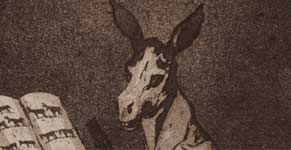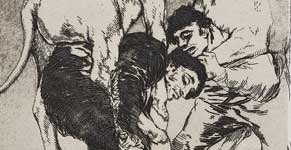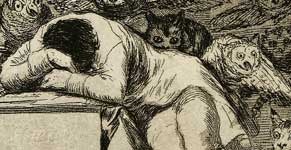Caprichos (caprices)
Prepared between 1796 and 1798 and published in 1799, this series consists of 80 prints and marked Goya’s establishment as an engraver. They appeared at a crucial time in the history of Spain, when the crisis of the Antiguo Régimen began. Goya had frequented the illustrious circles of Madrid since the 1780s, building friendships with intellectuals like Ceán Bermúdez, Meléndez Valdés, Jovellanos and Moratín. As a participant in Enlightenment culture, Goya shared in the enlightened classes’ desire for progress, which would be achieved by applying reason, ‘lights’ attained through economic, social and educational reform to reverse the secular backwardness of Spain and end the atavistic practices and vices that dulled its peoples.
This enlightened attitude led Goya to express his view of the situation in Spain with critical imagery that could also easily be generalised to other contexts at the same time because much of it addressed universal failings. As quoted in the announcement in the Gaceta de Madrid, the painter wanted to ‘highlight some of the many extravagances and mistakes that are common to all civil societies, and well as some concerns and vulgar myths authorised by custom, ignorance or interest that he deemed most likely to provide material for ridicule and to exercise his imagination’.
Goya mixed high-brow and popular tastes, references to plays and literature and to contemporary events that made a splash in the newspapers to engage in satirical and moralising criticism of vices and problems present in Spanish society. His learned criticism targeted popular superstition and ignorance and the economically and socially unproductive privileged classes (nobility and regular clergy). He also highlighted the incompetence of professional and political groups, as well as vice and corruption in society, such as prostitution, marriages of convenience, the poor or non-existent education of most Spanish children at the time, the violence commonly used against them, hypocrisy and the lack of empathy. He also lambasted the Inquisition, an institution greatly reviled by the enlightened classes and responsible for repressing any religious, moral or ideological deviations, and witchcraft, an important subject in the series. There is no shortage of silly situations to criticise ignorant teachers and doctors, nobles who use rent and lordly rights to exploit the peasants and fatuous patrons of the arts like Godoy.
Third edition (1868), Calcografía Nacional.





